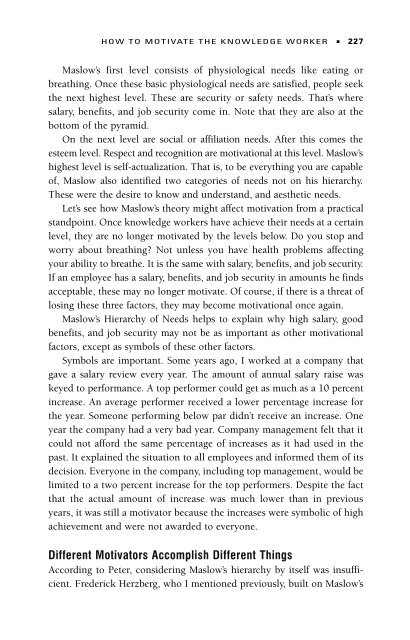A Class with Drucker - Headway | Work on yourself
A Class with Drucker - Headway | Work on yourself
A Class with Drucker - Headway | Work on yourself
Create successful ePaper yourself
Turn your PDF publications into a flip-book with our unique Google optimized e-Paper software.
HOW TO MOTIVATE THE KNOWLEDGE WORKER ■ 227<br />
Maslow’s first level c<strong>on</strong>sists of physiological needs like eating or<br />
breathing. Once these basic physiological needs are satisfied, people seek<br />
the next highest level. These are security or safety needs. That’s where<br />
salary, benefits, and job security come in. Note that they are also at the<br />
bottom of the pyramid.<br />
On the next level are social or affiliati<strong>on</strong> needs. After this comes the<br />
esteem level. Respect and recogniti<strong>on</strong> are motivati<strong>on</strong>al at this level. Maslow’s<br />
highest level is self-actualizati<strong>on</strong>. That is, to be everything you are capable<br />
of, Maslow also identified two categories of needs not <strong>on</strong> his hierarchy.<br />
These were the desire to know and understand, and aesthetic needs.<br />
Let’s see how Maslow’s theory might affect motivati<strong>on</strong> from a practical<br />
standpoint. Once knowledge workers have achieve their needs at a certain<br />
level, they are no l<strong>on</strong>ger motivated by the levels below. Do you stop and<br />
worry about breathing? Not unless you have health problems affecting<br />
your ability to breathe. It is the same <str<strong>on</strong>g>with</str<strong>on</strong>g> salary, benefits, and job security.<br />
If an employee has a salary, benefits, and job security in amounts he finds<br />
acceptable, these may no l<strong>on</strong>ger motivate. Of course, if there is a threat of<br />
losing these three factors, they may become motivati<strong>on</strong>al <strong>on</strong>ce again.<br />
Maslow’s Hierarchy of Needs helps to explain why high salary, good<br />
benefits, and job security may not be as important as other motivati<strong>on</strong>al<br />
factors, except as symbols of these other factors.<br />
Symbols are important. Some years ago, I worked at a company that<br />
gave a salary review every year. The amount of annual salary raise was<br />
keyed to performance. A top performer could get as much as a 10 percent<br />
increase. An average performer received a lower percentage increase for<br />
the year. Some<strong>on</strong>e performing below par didn’t receive an increase. One<br />
year the company had a very bad year. Company management felt that it<br />
could not afford the same percentage of increases as it had used in the<br />
past. It explained the situati<strong>on</strong> to all employees and informed them of its<br />
decisi<strong>on</strong>. Every<strong>on</strong>e in the company, including top management, would be<br />
limited to a two percent increase for the top performers. Despite the fact<br />
that the actual amount of increase was much lower than in previous<br />
years, it was still a motivator because the increases were symbolic of high<br />
achievement and were not awarded to every<strong>on</strong>e.<br />
Different Motivators Accomplish Different Things<br />
According to Peter, c<strong>on</strong>sidering Maslow’s hierarchy by itself was insufficient.<br />
Frederick Herzberg, who I menti<strong>on</strong>ed previously, built <strong>on</strong> Maslow’s


